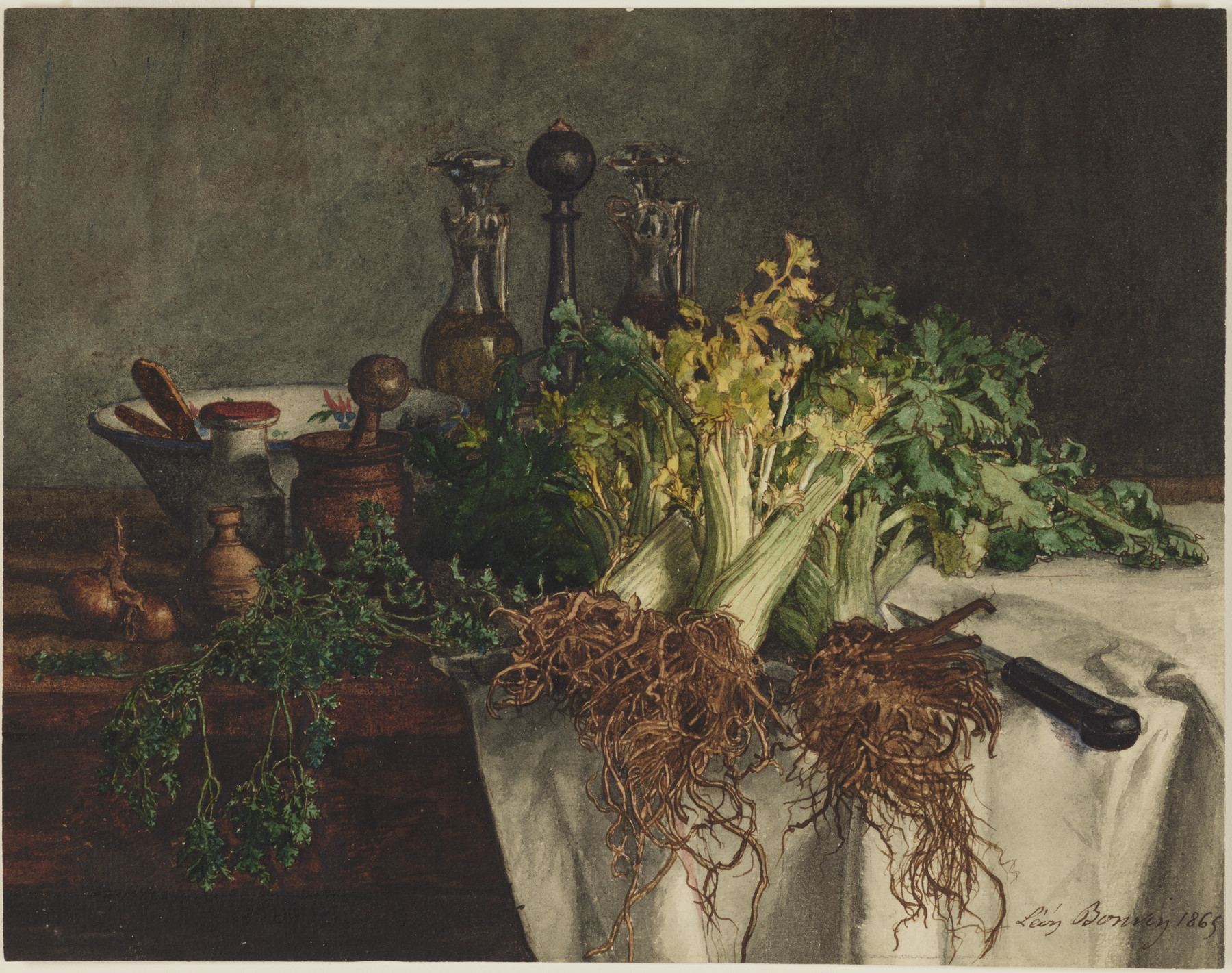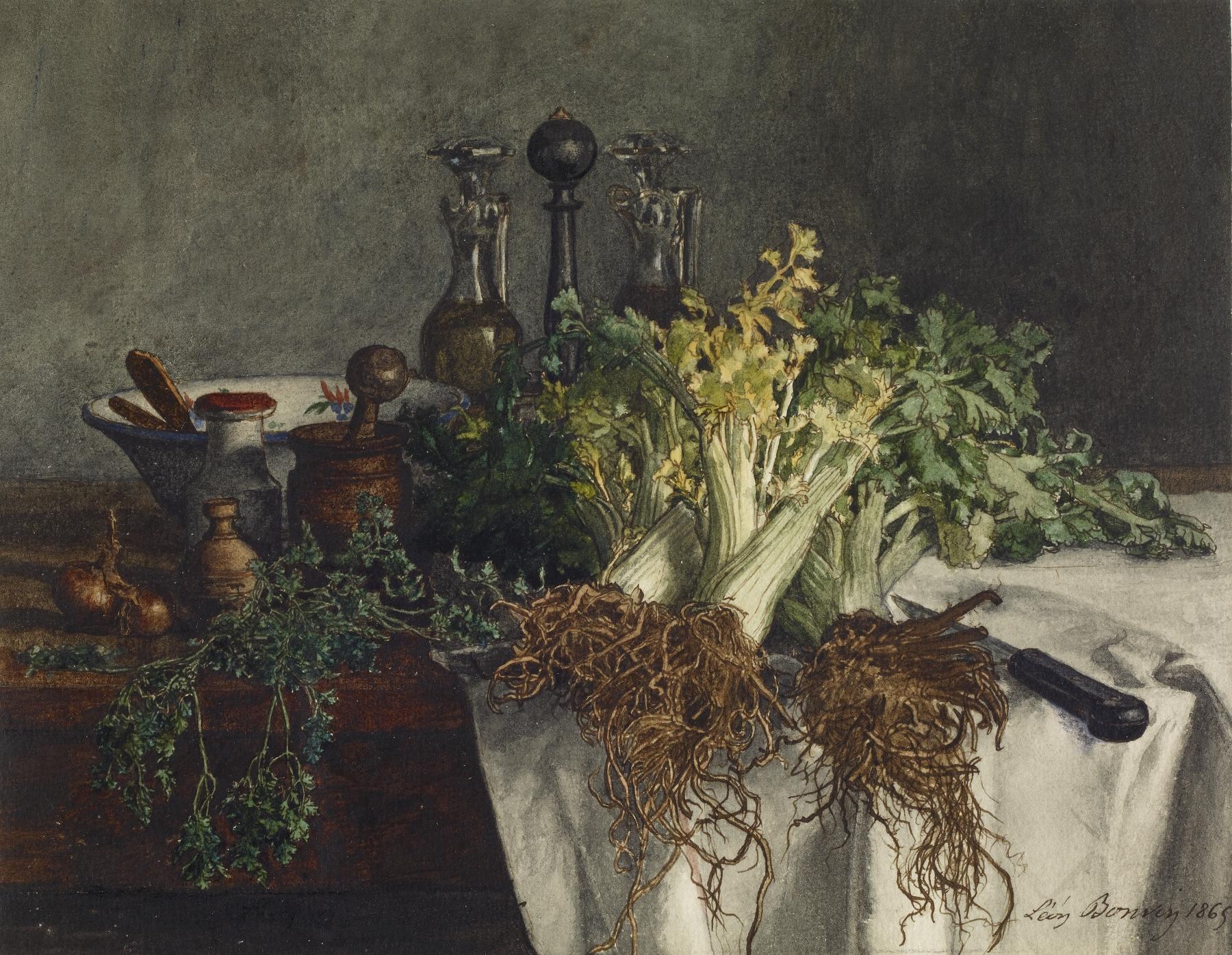Still Life with Celery
(18th and 19th Centuries )
In about 1863, Bonvin began to paint still-lifes portraying informal arrangements of commonplace flowers, vegetables, and kitchen implements. In this instance, on the tabletop partly covered by a white cloth, there are three heads of celery, some parsley, several garlic bulbs, and various utensils including a knife, a cruet set, a pestle and mortar, and a faience bowl. The same combination of kitchen implements, particularly the knife extending over the table's edge, and the cloth with clearly defined folds, figured in the still-lifes of Bonvin's older half brother François at this time and was also dominant in Manet's paintings of the mid-1860s. These works adhered to a tradition that can be traced to the still-lifes of Chardin and ultimately to Dutch 17th-century precedents. Distinctive of Léon Bonvin's approach was the humble nature of the fare. Philippe Burty recalls that Bonvin, compelled to paint at night, frequently drew his still-lifes using a lamp enclosed in a box with a small opening as a light source, a practice that sometimes imparted a slightly acid color to the greens (Burty, "Léon Bonvin," in "Harpers New Monthly Magazine," 75, January 1886: 37-51). In this drawing, the artist's obsession with detail is clearly manifested in his treatment of the intricate mass of the celery roots. He often outlined the forms in ink and then applied colored washes.
Inscription
Provenance
Provenance (from the French provenir, 'to come from/forth') is the chronology of the ownership, custody, or location of a historical object. Learn more about provenance at the Walters.
William T. Walters, Baltimore, by puchase, 1872 (through George A. Lucas as agent) [1]; Henry Walters, Baltimore, 1894, by inheritance; Walters Art Museum, 1931, by bequest.
[1] A watercolor by Bonvin matching this description was sold at the Hotel Drouot, Paris, on 9 February 1872 (see "Catalogue de tableaux, aquarelles et dessins, anciens et modernes formant la collection de M. E. A.," p. 39). Lucas records in his diary entry for that day, "At Hotel & bought two Bonvins for Walters - 170.40 fs" (see Randall, Diaries of George A. Lucas, vol. 2, p. 356)
Exhibitions
| 2022-2023 | Léon Bonvin (1834-1866). Fondation Custodia, Paris. |
| 2023 | Quiet Beauty: The Watercolors of Léon Bonvin. The Walters Art Museum, Baltimore. |
| 2005-2006 | The Essence of Line: French Drawings from Ingres to Degas. The Walters Art Museum, Baltimore; Baltimore Museum of Art, Baltimore; Birmingham Museum of Art, Birmingham; Tacoma Art Museum, Tacoma. |
| 1980-1981 | The Drawings and Watercolors of Léon Bonvin. The Cleveland Museum of Art, Cleveland; The Walters Art Gallery, Baltimore. |
Conservation
| Date | Description | Narrative |
|---|---|---|
| 5/15/1972 | Treatment | re-housed |
| 6/20/1979 | Examination | examined for loan |
| 9/2/1980 | Examination | examined for exhibition |
| 1/1/2002 | Treatment | examined for exhibition; other |
Geographies
France (Place of Origin)
Measurements
H: 6 9/16 × W: 8 11/16 in. (16.67 × 22.07 cm)
Framed H: 21 1/4 × W: 16 1/4 × D: 1 5/16 in. (53.98 × 41.28 × 3.33 cm)
Credit Line
Acquired by William T. Walters, 1872
Location in Museum
Not on view
Accession Number
In libraries, galleries, museums, and archives, an accession number is a unique identifier assigned to each object in the collection.
In libraries, galleries, museums, and archives, an accession number is a unique identifier assigned to each object in the collection.
37.1504






